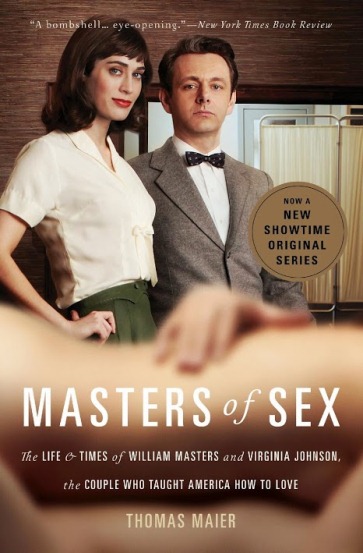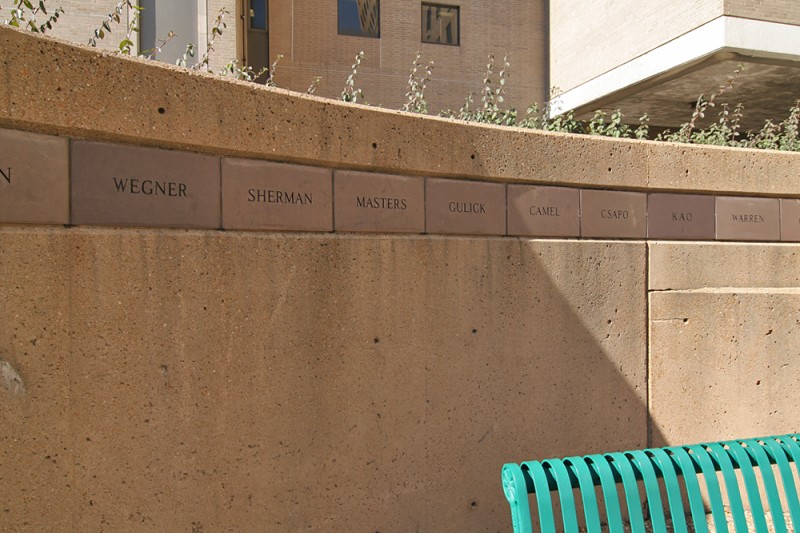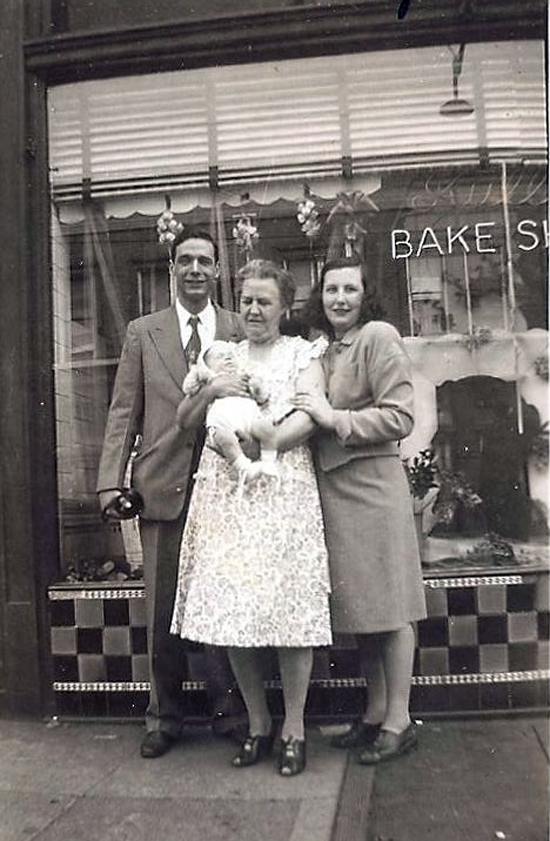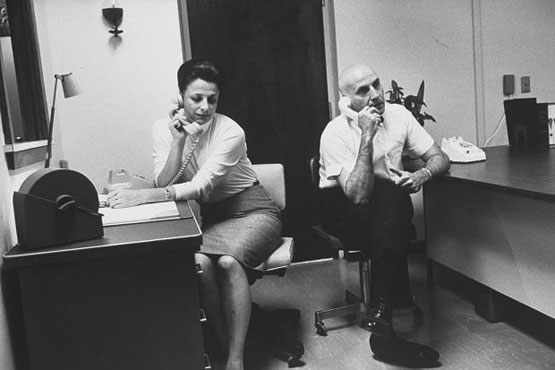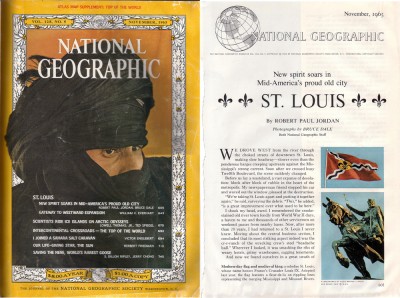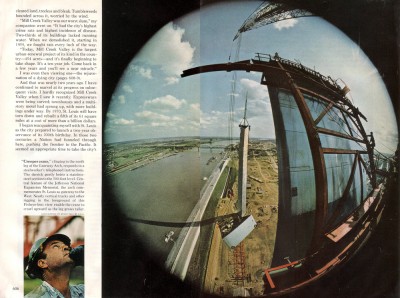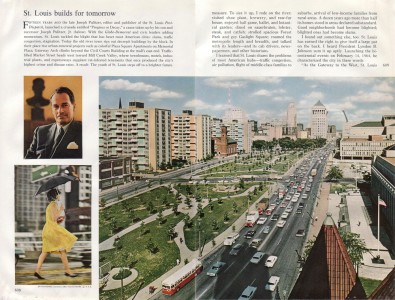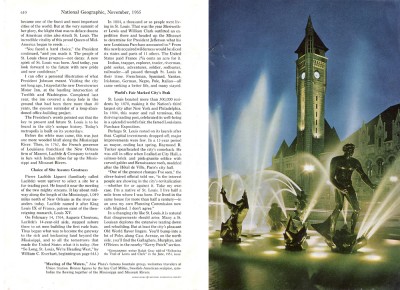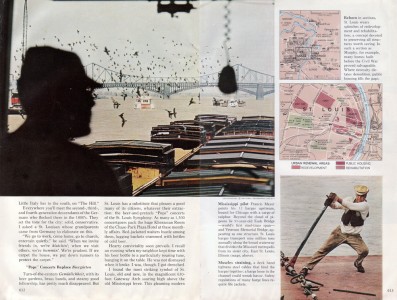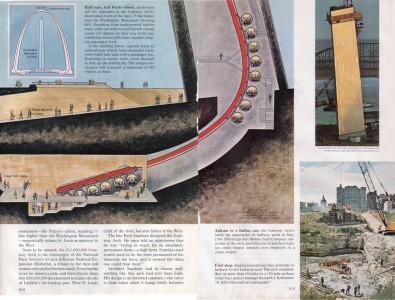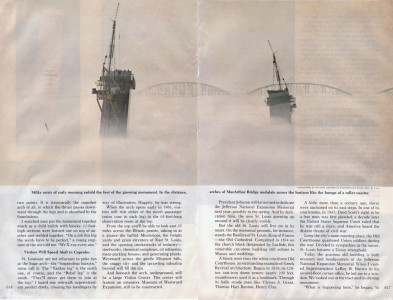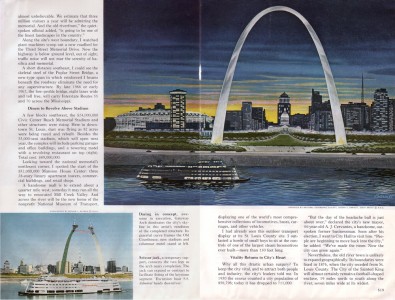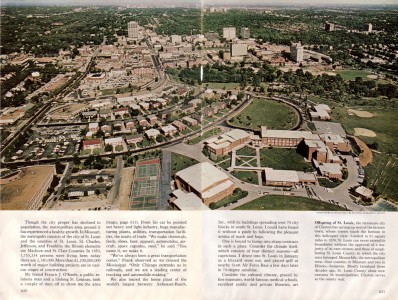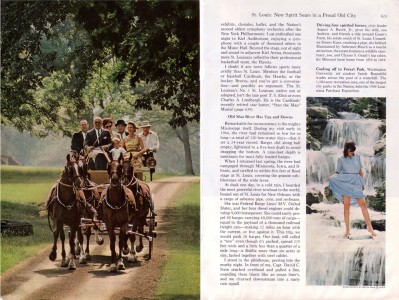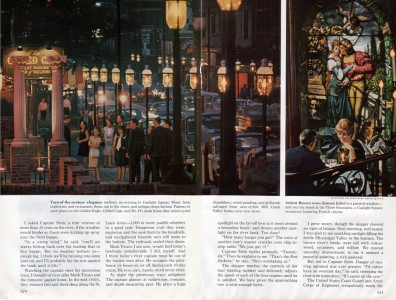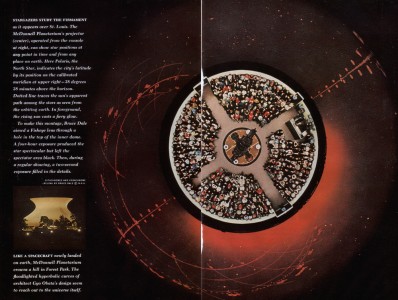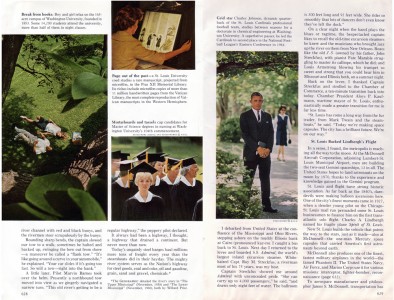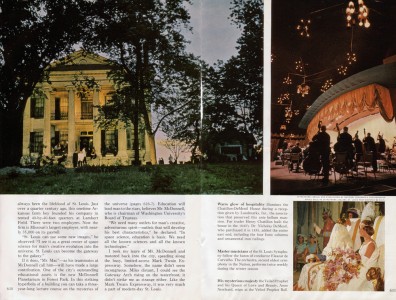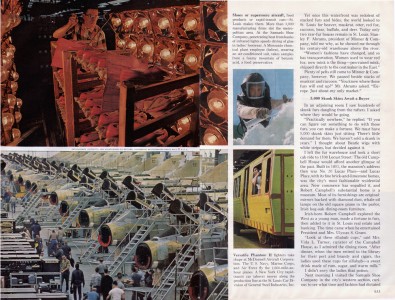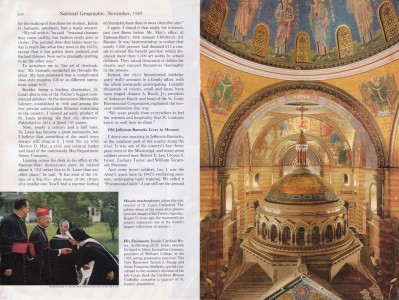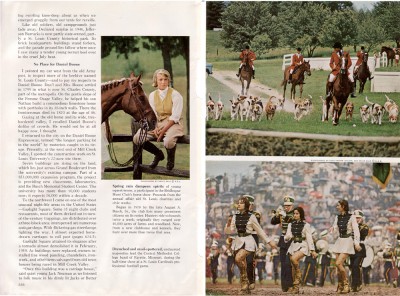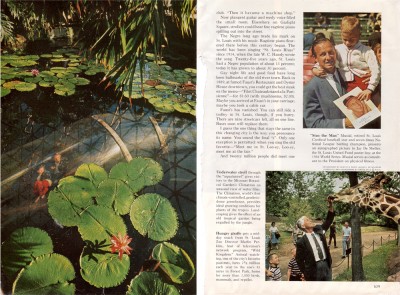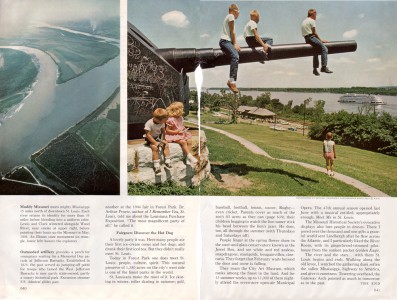The editor of St. Louis At Home asked me to dig into the real life locations depicted on the Showtime series Masters of Sex. See the Masters of Sex St Louis At Home article. Also available on-line without the photos.
Here we recap the article’s content with room to spread out, and add more engrossing details uncovered during the research process.

Maternity Hospital, erected 1926, still stands in the Barnes-Jewish Hospital complex at Kingshighway and Interstate 64.
The series opens in December 1956 with the newly-divorced Virginia Johnson interviewing for her eventual position as Dr. William Masters’ assistant. Master’s office is in Maternity Hospital, shown as a handsome Art Deco hospital of white stucco. That was the first instance of TV separation from St. Louis reality, for the 1926 Maternity Hospital still stands today inside the Barnes-Jewish Hospital complex.
Dr. Master’s office and practice was on the 3rd floor of this building, and other than the exterior facade and some molding and terrazzo flooring touches at the entrances, everything has been remodeled countless times since the 1950s. Very little about Master’s and his ground-breaking work remains within the record books of the hospital or Washington University. Local theory is that ultra-conservative St. Louis academia still finds it offensive to acknowledge his pioneering sex studies. Though his last name does make the list of blocks inside the circular wall of this outdoor smoking lounge in front of the building (below).
Still with the first episode, we see Dr. William Masters and his wife Libby living in an exquisite mid-century modern ranch home, which for 1956 would have put them on the cutting edge of St. Louis modern design, something a successful doctor could afford to indulge in. Meanwhile single-mother-of-two Virginia Johnson is shown living in one side of a 2-story, stucco duplex. Other than some more stucco (St. Louis just doesn’t have the climate for it), this type of living arrangement for Virginia is logical. So are these homes based on their real life domiciles, and if so, where are they?

Masters of Sex exterior establishing shot of St. Louis brothel where Dr. Masters conducted research.
Episode 2 of Masters of Sex really lit a fire when they gave an establishing exterior shot of a local brothel (above). But it was a bit disconcerting that this was the 3rd or 4th time that wood clapboard homes were shown as the norm. Even to the distracted eye, St. Louis is a brick city – we don’t see wood siding as a constant until the post-WW2 suburbs. And it’s a cinch that a whorehouse would have to be inside St. Louis City boundaries, where a home of this type would be very rare.
I was distracted with these type of architecture geek thoughts when the thoroughly engaging prostitute character Betty DiMello revealed that the sex study had moved “to a cathouse on Third & Sutter.” I waited for the episode to end before digging into maps of both St. Louis and East St. Louis, where there is no such intersection. So exactly where was this whorehouse?
It was now time to dig into the source material for the TV show, the 2009 book Masters of Sex: The Life and Times of William Masters and Virginia Johnson, the Couple Who Taught America How to Love by Thomas Maier. It’s a factually dense book that easily moves you forward with anticipation. And this book sent me into obsessive research mode, deciphering fact from TV fiction.
As the first season unfolded, it was addictive to figure out how the show’s creators and writers took the original and transformed it into an episodic drama. How a one-off sentence in the book becomes a story-arc, or how two different real life people are melded into one character with a completely fictitious yet fascinating backstory.

The mid-century modern ranch designed by architect “Eine,” home to the TV version of Dr. William & Libby Masters.
One of the most revelatory differences between fact and artistic license is the home of Dr. William and Libby Masters. The viewer gets a distinct Mad Men vibe from their clean-lined, suburban mid-century modern ranch home. Maier’s book describes their real-world house as a “brick two-story Colonial” in “Ladue, an affluent suburb of St. Louis.” And here is their former home, built in 1934:
The show’s producers made a conscious decision to place William & Libby in a new, atomic age home. They also added an infertility problem to their marriage, whereas in real life, they had two children by 1953. But one fact did remain intact: Libby & Bill did sleep in separate twin beds! (And here’s a gossipy fact: they installed an in-ground pool to this home in 1967, and the neighbors were scandalized to see Virginia Johnson lounging by it while Libby was out of town.)
Other deviations from fact to television fiction include:
• There’s no Provost Scully (as portrayed by Beau Bridges); he’s a combination of a few men at Washington University, including Chancellor Ethan Shepley.
• There’s no real-life prostitute Betty DiMello, which means it’s unlikely anyone ever called Dr. Masters the “alpha dog of coochie medicine.”
• Dr. Ethan Haas and Gene The Pretzel King are made up characters (so there is no Gus’ Pretzel connection to Masters & Johnson, sorry)
• St. Louis has yet to have a Rialto movie theater (so the entirely fictitious Dr. Austin Langham never banged the entirely fictitious Margaret Scully in a car parked in front of it)
• St. Louis never had a Gardell’s, described in the show as a “nightclub in Coontown” (though senior citizen St. Louisans can tell you the rough whereabouts of the part of town once referred to by that wince-inducing moniker).
• St. Louis never had a Commodore Hotel where gay male prostitutes set up shop. There were plenty of other gay haunts in the City during that time period (like the Grandel Square Hotel once at 3625 Grandel Square; the Golden Gate bar on Olive Street and Entres Nous on Pine Street), so the creators appear to have condensed that St. Louis scene into one convenient package.
According to Maier’s research, there was most definitely a cathouse where Dr. Masters conducted research. He writes about how St. Louis Chief of Police H. Sam Priest protected Masters (who delivered their second child) so he could conduct studies in local brothels. Chief Priest and his detectives found willing candidates among prostitutes and made sure they were not busted in the weeks before and after the testing.
Maier writes, “Between 1955 and late 1956, Masters expanded his study in such St. Louis neighborhoods as the Central West End to interviews with call girls in other American cities, such as Chicago, Minneapolis and New Orleans.”
Ah ha! We have a locale on the brothel!
But it’s not like old City Directories are going to list them as such, or old newspapers are going to report any fine details about raiding them. And since I had other questions needing clarification, I reached out to Thomas Maier, who was refreshingly friendly, helpful and prompt in his replies.

A real-life example of the home Virginia Johnson lived in after her 1956 divorce. Her actual home was in the spot of the modern condo shown to the left of this home.

By the early 1960s, Virginia Johnson moved into this ranch home in Salem Estates in Ladue, MO, a “traditional subdivision” designed by St. Louis architect Ralph Fournier.
As learned from Maier, the Masters of Sex producers have yet to visit St. Louis, which explains the architectural discrepancies. While filming the pilot, the producers found a mid-century home in Huntington, NY that they liked, and later reproduced it on Sony’s Hollywood lot. An old wing of the Jamaica Hospital in Queens, NY stood in for Maternity Hospital. And even though the scenes set on the Washington University campus looked authentic, it’s actually the former Guggenheim estate in Long Island, NY.
He also only knows the general location of the whorehouse as Central West End. Dang it!
I am a life-long, ardent participant in the suspension of disbelief that is Hollywood. But the first season’s episodes aired while I was deeply consumed by Maier’s book and my research, and I found myself second-guessing and dismaying over the deviations from Masters & Johnson’s actual story. Which kinda killed my buzz – totally of my own doing. But it did not keep me from watching and thrilling to every episode, it only clarified that I need to apply more effort to maintain my Hollywood vs. Reality balance.
And the producers’ decision to put Dr. Masters in an MCM ranch did eventually pan out in real life:

The mid-century modern ranch in Ladue, MO that Dr. William Masters & Virginia Johnson moved into after their 1971 marriage.
Above is the home, built in 1951, that Bill & Gini (since we got this far, it’s OK to use their nicknames, right?) moved into after they were married in 1971. Oh please oh please let the series go on long enough to get to that soap opera plot twist!
Anyway, this home became a place for their more famous or notorious clients to stay for therapy, avoiding possible detection at the more public Reproductive Biology Research Foundation office at 4910 Forest Park Blvd. (long-since torn down). From the book:
The Ladue house on South Warson Road was more contemporary than most, sheltered by tasteful plantings that shielded activity from the street. Upon entering, guests walked into a vestibule and could follow one of two ramps – to a spacious dining room and kitchen on one side, and to several bedrooms on the other, including the master suite with two king-sized beds placed together. In the back of the house were a large terrace, a kidney-shaped inground pool, and a stable with enough surrounding acreage for Johnson’s daughter, Lisa, to ride her horse. When Cindy Todorovich later bought the South Warson house, she found a secret panel with a peephole. “I’m not saying there was anything kinky going on, but maybe it had something to do with their research,” she recalled.

Apartment building at Maryland Avenue & North Taylor in St. Louis’ Central West End, home of Dr. Masters’ mother, Estabrook.
The book also has some fun facts that seriously need to go into the series.
The apartment building shown above is where Dr. Masters’ mother, Estabrook, moved to after she was widowed. The child abuse and transformation of his mother’s personality as shown in the series is true. What also needs to be shared is that the staff of Masters & Johnson’s Repro Bio office often spent their lunch hours at Estabrook’s apartment on the 8th floor, because it was a nice walk to and from the office. And since she was now privy to the details of their work, she helped out by sewing silk masks for study volunteers to wear to protect their anonymity.
So Where’s the Brothel?
I made endless inquiries to pinpoint the locale of this place (or places). Librarian friends at both the St. Louis City and County libraries worked on it (along with providing assistance in digging up old phone book and directory information – thanks Adele!), and I followed all leads about anyone who knew a cop or a friend who had brothel info.
Elder St. Louisans mused that a brothel in St. Louis city couldn’t have existed for very long without being busted, and they certainly wouldn’t have been in such luxurious quarters as shown in the screen cap earlier in this post. And the 1952 book U.S.A. Confidential by Jack Lait & Lee Mortimer verified that there was an “overpopulated harlot population” in St. Louis, including “a lot of call-girls” moving “into the new Ford Apartments.”
It was the friend of a friend who verified that a city brothel just wouldn’t be all that glamorous. Roland Kulla is a St. Louis native now living in Chicago, and he shared the following memories and photos from when he lived in the eastern border of the Central West End:
“I lived at 3850 Olive St. near the Vandeventer Ave. intersection, from 1947-1954. The street was very busy then – lots of shops, and bars and a small department store across the street, the streetcar line ran down Olive. We lived in an apartment above my uncle’s bakery, Sausel’s (new-born Roland is shown with his family in front of that bakery, above) where my father worked. Stories about the brothel next door at 3848 came from my mother, as I was too young to know.
“The buildings on that corner formed a courtyard in the back. You came through a yard to get to the back door. Our back doors were right next to each other – although there was a wooden fence between them (photo below). Mom told the tale that sometimes the clients would knock on our door by mistake.

Roland Kulla and his friends in front of the fence that separated their yard from that of the brothel next door.
“(The brothel situation) had changed by 1954 when we moved, as there was a legit neighbor there that we were friendly with. The layout of the apartment, which would have been similar to the one next door, was a small bedroom in the front over the stairs. There was a double parlor – the front one with a fireplace – divided by sliding doors. We used both parlors as bedrooms, with the small one used the nursery since there was always a new baby. Beyond that was a hall bath, and then a big dining room that went the width of the building. And then a big kitchen in the rear with two walk-in pantries.”

The rear of the buildings (since demolished) on Olive. A wood fence separated 3850 from the brothel at 3848.
Roland took the two photos above in the early 1990s. The buildings were completely demolished about 10 years ago, with only The Lighthouse of The Blind building (which formed the east flank of the rear courtyard) remaining on the block.
We are in no way implying or supposing this was the location of Dr. Masters’ laboratory, especially since it was cleaned up prior to beginning his local field studies in 1955-56. It does verify that such places existed, and for long stretches of time, and they were not opulent.
My hope is that I will eventually run across a retired St. Louis City cop who worked under Chief Priest, or had passed-down knowledge of assistance for Dr. Masters, and that so much time has passed they are willing to talk location details. If you’re as curious as I am about finding Bill’s cathouse, and know someone who knows these kinds of things, please let me know. The seedy underbelly of St. Louis was deep and vivid, and in this particular case, led to major scientific discoveries that permanently and positively altered the sexual landscape. If those brothel buildings still stand, they deserve an historic marker, don’t you think?

